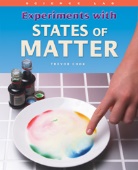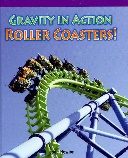-
 Because of the biological similarities between many animals and humans, scientists can learn about diseases, and find out how humans might react to medicines, cosmetics, chemicals, and other products by testing them on animals first. According to the Humane Society of the United States, more than twenty-five million animals are used in research, testing, and education each year. Readers learn about the various philosophies on animal testing, what tests are used, and how they are performed. The book presents the pros and cons of animal testing and some of the alternative methods to animal testing that scientists are developing today.
Because of the biological similarities between many animals and humans, scientists can learn about diseases, and find out how humans might react to medicines, cosmetics, chemicals, and other products by testing them on animals first. According to the Humane Society of the United States, more than twenty-five million animals are used in research, testing, and education each year. Readers learn about the various philosophies on animal testing, what tests are used, and how they are performed. The book presents the pros and cons of animal testing and some of the alternative methods to animal testing that scientists are developing today. -
 Artificial Intelligence is one of the most intriguing and difficult technological advances ever explored by man. It is the study of intelligent behavior and the attempt to recreate it through technology. This beginner's guide explores, not only the technology behind AI, but the current and future benefits of further exploration.
Artificial Intelligence is one of the most intriguing and difficult technological advances ever explored by man. It is the study of intelligent behavior and the attempt to recreate it through technology. This beginner's guide explores, not only the technology behind AI, but the current and future benefits of further exploration. -
 The spread of harmful chemicals and biological organisms can injure and kill thousands of people and make an infected area unlivable for some time to come. In the age of modern terrorism, many people fear militant organizations will unleash chemical and biological weapons in public places. This book provides readers with an overview of what these weapons are, who uses them and why, and explains how much of a threat they are to our way of life. Over time, countries have pledged to ban the use of CBWs in various agreements, with limited success.
The spread of harmful chemicals and biological organisms can injure and kill thousands of people and make an infected area unlivable for some time to come. In the age of modern terrorism, many people fear militant organizations will unleash chemical and biological weapons in public places. This book provides readers with an overview of what these weapons are, who uses them and why, and explains how much of a threat they are to our way of life. Over time, countries have pledged to ban the use of CBWs in various agreements, with limited success. -
 This is a well-organized look as coastal regions: what shapes them, some environmental threats, and their usefulness in industry and tourism. Several beautiful and interesting coastlines are highlighted, including Cancun and the Great Barrier Reef. Readers will learn about each coastline's location, population, local industries, and environmental threats.
This is a well-organized look as coastal regions: what shapes them, some environmental threats, and their usefulness in industry and tourism. Several beautiful and interesting coastlines are highlighted, including Cancun and the Great Barrier Reef. Readers will learn about each coastline's location, population, local industries, and environmental threats. -
 Some of the most important contributors to the food chain are those creatures that help break things down: decomposers. If not for these birds, bugs, and worms organic matter couldn't be recycled back into nature. Readers will discover the different kinds of decomposers, how they do their job, and why it is so important. This fascinating book includes graphic organizers and annotated illustrations to better explain the food chain.
Some of the most important contributors to the food chain are those creatures that help break things down: decomposers. If not for these birds, bugs, and worms organic matter couldn't be recycled back into nature. Readers will discover the different kinds of decomposers, how they do their job, and why it is so important. This fascinating book includes graphic organizers and annotated illustrations to better explain the food chain. -
 The world's wildlife is vanishing at an alarming rate. Scientists at the Nature Conservancy and the World Wildlife Federation estimate that one in four mammals, and a full third of Earth's amphibians are in danger of becoming extinct. Today species are becoming extinct at a rate that is anywhere from 100 to 1,000 times faster than normal. People have been in fierce competition with wild animals for land, food, and natural resources for years. When over-hunting and -fishing of species and a rise in the level of pollution is added to this mix, humans come to represent the single gravest threat to wildlife survival. Any species that disappears leaves a hole in the web of life. Mass extinction would leave so many holes that the web might totally fall apart. Humans must realize the important role wildlife plays in the survival of the planet and reverse the damage--before it's too late.
The world's wildlife is vanishing at an alarming rate. Scientists at the Nature Conservancy and the World Wildlife Federation estimate that one in four mammals, and a full third of Earth's amphibians are in danger of becoming extinct. Today species are becoming extinct at a rate that is anywhere from 100 to 1,000 times faster than normal. People have been in fierce competition with wild animals for land, food, and natural resources for years. When over-hunting and -fishing of species and a rise in the level of pollution is added to this mix, humans come to represent the single gravest threat to wildlife survival. Any species that disappears leaves a hole in the web of life. Mass extinction would leave so many holes that the web might totally fall apart. Humans must realize the important role wildlife plays in the survival of the planet and reverse the damage--before it's too late. -
 Now the best-selling book of its kind has gotten even better. This revised and expanded second edition of Ittelson’s master work will give you that firm grasp of “the numbers” necessary for business success. With more than 100,000 copies in print, Financial Statements is a perfect introduction to financial accounting for non-financial managers, stock-market investors, undergraduate business and MBA students, lawyers, lenders, entrepreneurs, and more.
Now the best-selling book of its kind has gotten even better. This revised and expanded second edition of Ittelson’s master work will give you that firm grasp of “the numbers” necessary for business success. With more than 100,000 copies in print, Financial Statements is a perfect introduction to financial accounting for non-financial managers, stock-market investors, undergraduate business and MBA students, lawyers, lenders, entrepreneurs, and more.






























